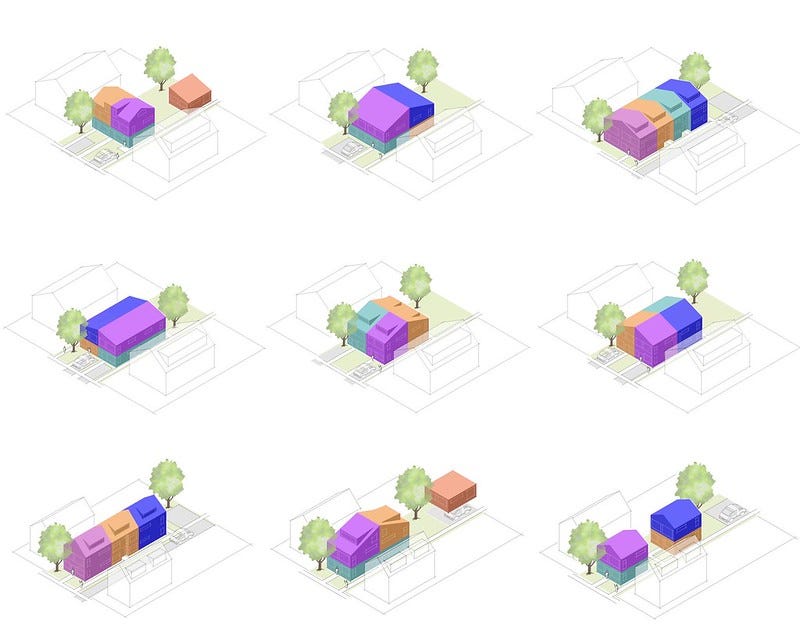If we have people who want to live and work here, and other people who want to build housing for them, why can’t we mass-produce housing, like we did during the postwar period?
A Twitter thread by Mike Moffatt on the benefits of pre-approved designs. These lay out everything: not just floor plans, but materials and construction methods.
Housing construction, from the actual building to financing to insurance to approvals, is ridiculously labour-intensive because *everything* is bespoke. Every project is a unicorn.
But it doesn't have to be this way.
Imagine what the automotive industry would be like if every car was built in the pre-Henry Ford way. If every single vehicle produced had to undergo air quality testing, etc.
We can fix this in the housing sector. A pre-approved catalogue of housing designs can allow building types to get (some forms) of approval once, and then not have to go through the same red tape when built again in another geography.
But the benefits go beyond approvals. If the homes are designed in a way to be labour-efficient, we can also substantially cut down on the amount of labour that goes into producing a home...
And you also get builders that can specialize in a particular design. And if they're building the same structure over and over, they're going to get more productive at it, reducing labour inputs even further.
And where it gets really great on the labour side is that designs could incorporate labour-efficient technologies from panelization to mass timber, to really drive innovation and increase the productivity of the sector.
BC: standardized designs for multiplexes
BC is developing standardized designs for multiplexes which can then be adopted by local governments, to make it easier, cheaper, and faster to get approval and build them. I hope it’ll include simple three-storey apartment buildings, as suggested by Michael Geller.
Press release, November 2023:
Through the new Standardized Housing Design Project, the Province is creating new standardized, customizable residential designs for small-scale, multi-unit housing built on single lots. These designs can be adopted by local governments and offered to builders and homeowners at a significantly below-market cost to expedite permitting and development. The Province is seeking to engage a consultant team to provide expert advice on the development of these designs.
Standardized designs can substantially streamline the permitting process to make it easier for local governments to give building-permit approvals quickly and save builders and homeowners the costs that come from expensive design services. They also assist smaller local governments that may not have the resources to develop standardized designs to help approve developments efficiently and quickly.
Federal government: standardized designs for low-rise and mid-rise buildings
The National Housing Accord proposal includes the following recommendation, aimed specifically at speeding up CMHC approvals for lending and insurance (MLI Select):
Create a catalogue of pre-approved housing designs, including mid-rise purpose-built rentals, that are energy-efficient, using innovative methods such as mass-timber and require less skilled labour than traditional forms. Developments that use these designs should be fast-tracked for CMHC and other approvals. This catalogue of pre-approved designs would speed up approval processes and create economies-of-scale for new building methods such as modular housing, lower costs through learning by doing and act as a “pull” mechanism to stimulate innovation in the homebuilding sector.
Press release, December 2023:
Consultations will begin in early January 2024 on a housing design catalogue initiative.
This new initiative will help accelerate the delivery of homes by standardizing housing designs, starting with low-rise construction. It will explore a potential catalogue to support higher density construction, such as mid-rise buildings, and different forms of housing construction, such as modular and prefabricated homes.
The government will also look at ways to support municipalities, provinces and territories looking to implement their own housing design catalogues.
Things to watch:
What happens with the potential catalogue of mid-rise designs?
Is it linked to CMHC approval for lending and insurance?
More
Vancouver specials, Montreal triplexes, Kelowna four-plexes.
The small post-war 1 1/2-storey house, Part One. Part Two. By Ottawa realtor Saul Svirplys, November and December 2020.
The rise and fall of the mail-order home. Brian Potter, July 2023. These were popular in the US before World War II.
Building an ADU in California? Save Time and Money with Pre-Approved Plans. Dwellito, May 2023.
Pre-Approved House Designs Jump-Start Infill Development in South Bend, Indiana. Daniel Herriges, Strong Towns, October 2022.
Say Yes to New Housing—Before Anyone Even Asks To Build It. Edward Erfurt and Lindsey Beckworth, Strong Towns, October 2023.






I'm skeptical that this is anything more than marketing. The G&M had an opinion piece about this -- basically, it's a headline to make it look like there's work being done on the housing front. The reality is that approvals happen locally, not federally, so unless all these designs are also approved by municipalities all over Canada, there's no real advantage. Many companies already have preapproved designs, as well.
Am I missing something? Moffat finds this development encouraging, but he knows better than anyone that the bottleneck isn't there.